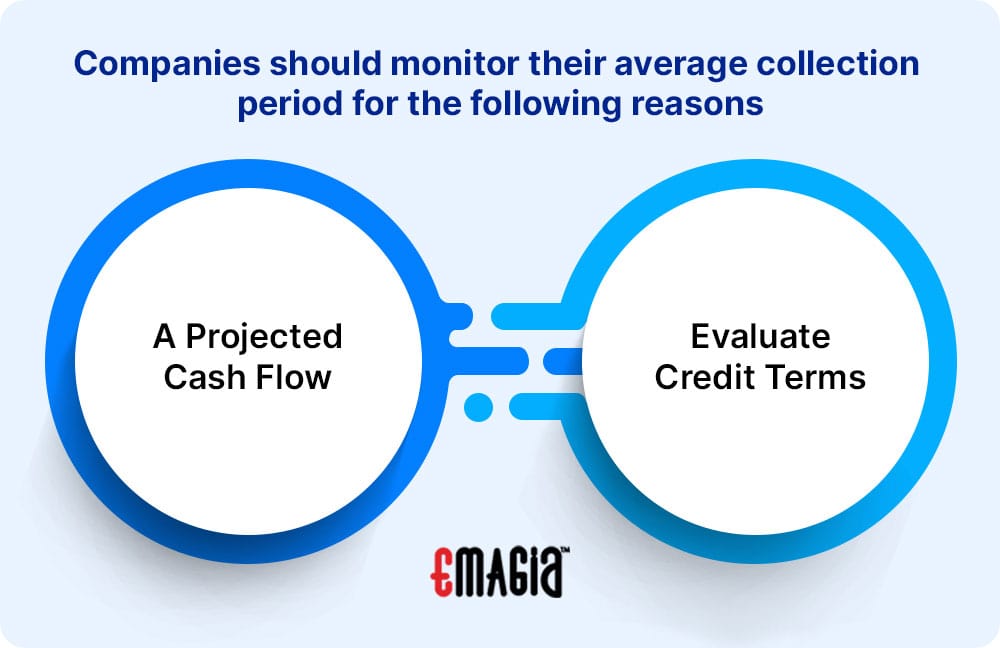The average collection period is an important accounting metric that evaluates a company’s ability to manage its accounts receivable (AR) effectively. It measures the time it takes for the business to collect payments from its clients, which reflects its cash flow effectiveness and ability to meet short-term financial obligations. It is a crucial indicator of a company’s financial health and liquidity.
The average collection period is a versatile tool that businesses use to forecast cash flow, evaluate loan conditions, track competitor performance, and detect early signs of poor debt allowances. By regularly measuring and evaluating this indicator, companies can identify trends within their own business and benchmark themselves against their competitors. It is an essential component of effective financial management.
What is an Average Collection Period?
The average collection period is the length of time it takes for a company to receive payment from its customers for accounts receivable (AR). This metric is critical for companies that rely on receivables to maintain their cash flow and meet financial obligations. By measuring the typical collection period, businesses can evaluate how effectively they manage their AR and ensure they have enough cash on hand.
Why is the Average Collection Period Critical to Track?
A company’s typical collection period offers useful information on its cash flow, credit terms, and accounts receivable health. Without observing the ACP, firms find it difficult to budget for upcoming costs and projects. Companies should monitor their average collection period for the following reasons:
1. A Projected Cash Flow
Businesses can forecast their collections scenario and adjust their spending planning by looking at the ACP. For instance, if a corporation has a 20 day old $500,000 AR balance with an average collection period of 25, it can anticipate receiving payment within a week.
2. Evaluate Credit Terms
Typically, a low DSO is advantageous for businesses. However, occasionally, a different scenario might play out. For instance, if a company’s ACP is 15 days but the industry average is closer to 30, it may indicate the credit terms are overly strict. Companies in these situations risk losing potential clients to rivals with superior lending standards.
How Average Collection Periods Work
Accounts receivable is a current asset that appears on a company’s balance sheet. It reflects the company’s liquidity and ability to pay short-term debts without depending on additional cash flows. The average collection period is a measure of how efficiently a company manages its accounts receivable. Generally, a smaller average collection period is more desirable as it indicates that the company gets paid promptly. However, a short average collection period may also suggest that the credit terms are too restrictive, causing customers to switch to more lenient providers.
The Formula for Average Collection Period
Importance of Average Collection Period
The average collection period sheds light on how effective debt collection is. The business cannot profit from the transaction until the money is received. The length of a company’s average collection period also indicates how severe its credit terms are. Strict terms may deter new consumers while excessively liberal terms may draw in clients who take advantage of such policies. The average collection period can be used to evaluate competitors’ performance. This offers more depth into what other businesses are doing and how a business’s operations stack up. Delays in payment from more clients may indicate that receivables are at risk of being uncollected, which should be closely monitored as an early warning sign of bad allowances. Overall, the average collection period is a valuable indicator for evaluating a company’s short-term financial health.
How to Use Average Collection Period
A company’s performance is compared to its rivals using the average collection period, individually or collectively. The average collection times serve as a good comparison because similar organizations would have comparable financial indicators. Businesses can assess their average collection period concerning the credit terms provided to clients. If the invoices are issued with a net 30 due date, a collection period of 25 days might not be a cause for concern. Since it directly affects the company’s cash flows, it is imperative to monitor the outstanding collection period.
Average Collection Period Example Calculation
Suppose a company generated$ 280k and$ 360k in net credit deals for the financial times ending 2020 and 2021, independently.
In 2020, the company’s ending accounts delinquent( A/ R) balance was$ 20k, which grew to$ 24k in the posterior time.
2020A
Net Credit Deals = $ 280k
Accounts Receivable( A/ R) = $ 20k2021A
Net Credit Deals = $ 360k
Accounts Receivable( A/ R) = $ 24k
We ’ll use the ending A/ R balance for our computations then and assume the number of days in the period is 365 days.still, we’d bear further literal data, If the normal A/ R balances were used rather.
Using those hypotheticals, we can now calculate the average collection period by dividing A/ R by the net credit deals in the matching period and multiplying by 365 days.
2020A = ($ 20k ÷$ 280k) × 365 Days = 26 Days
2021A = ($ 24k ÷$ 360k) × 365 Days = 24 DaysFrom 2020 to 2021, the average number of days demanded by our academic company to collect cash from credit deals declined from 26 days to 24 days, reflecting an enhancement time-over-year( YoY).
In the coming part of our exercise, we ’ll calculate the average collection period under the indispensable approach of dividing the receivables development by the number of days in a time.
2020A = $ 280k ÷$ 20k = 14.0 x
2021A = $ 360k ÷$ 24k = 15.0 xUpon dividing the receivables development rate by 365, we arrive at the same inferred collection ages for both 2020 and 2021 — attesting our previous computations were correct.
2020A = 365 Days ÷14.0 x = 26 Days
2021A = 365 Days ÷15.0 x = 24 Days
Conclusion:
In conclusion, the average collection period is an important indicator for companies to track. It offers information about a business’s financial stability, credit practices, and cash flow management. Companies can decide how to run their business more effectively by examining the average collection period. The average collection duration can be compared to industry norms and rival companies in order to assess their performance and make the required corrections. The efficient operation and viability of a business are dependent on maintaining a healthy average collection period in today’s cutthroat business environment.
Frequently Asked Questions:
How do You Interpret the Collection Period?
You have to divide a company’s average accounts receivable balance by the net credit sales and then multiply the quotient into 365 days.
What is a High Average Collection Period?
If you have a high average collection period, your corporation will have to deal with a smaller amount of problems.
What is a Low Average Collection Period?
If you have a low average collection period, customers take a shorter time to pay their bills.
What is a Good Collection Rate?
It should be 95% minimum.






